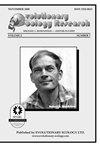Habitat choice and female preference in a polymorphic stickleback population
Q2 Agricultural and Biological Sciences
引用次数: 6
Abstract
Background: A small pond, c. 90 years old, near Bern, Switzerland contains a population of threespine stickleback (Gasterosteus aculeatus) with two distinct male phenotypes. Males of one type are large, and red, and nest in the shallow littoral zone. The males of the other are small and orange, and nest offshore at slightly greater depth. The females in this population are phenotypically highly variable but cannot easily be assigned to either male type. Question: Is the existence of two sympatric male morphs maintained by substrate-associated male nest site choice and facilitated by female mate preferences? Organisms: Male stickleback caught individually at their breeding sites. Females caught with minnow traps. Methods: In experimental tanks, we simulated the slope and substrate of the two nesting habitats. We then placed individual males in a tank and observed in which habitat the male would build his nest. In a simultaneous two-stimulus choice design, we gave females the choice between a large, red male and a small, orange one. We measured female morphology and used linear mixed effect models to determine whether female preference correlated with female morphology. Results: Both red and orange males preferred nesting in the habitat that simulated the slightly deeper offshore condition. This is the habitat occupied by the small, orange males in the pond itself. The proportion of females that chose a small orange male was similar to that which chose a large red male. Several aspects of female phenotype correlated with the male type that a female preferred.多态棘鱼种群的生境选择和雌性偏好
背景:瑞士伯尔尼附近的一个小池塘,大约90岁,里面有一个三刺棘鱼(Gasterosteus aculeatus)种群,有两种不同的雄性表型。其中一种雄性体型较大,呈红色,在浅海岸区筑巢。另一种雄性是小的,橙色的,在离岸稍深的地方筑巢。这个群体中的雌性在表型上是高度可变的,但不容易被分配到任何一种雄性类型。问题:两种同域雄性形态的存在是否通过与基质相关的雄性巢穴选择和雌性配偶偏好来维持?有机体:在繁殖地单独捕获的雄性刺鱼。被鲦鱼陷阱捕获的雌性。方法:在实验池中模拟两种筑巢生境的坡度和基质。然后,我们把雄性个体放在一个水箱里,观察雄性会在哪个栖息地筑巢。在同时进行的双刺激选择设计中,我们让雌性在一个大的红色雄性和一个小的橙色雄性之间做出选择。我们测量了雌性形态,并使用线性混合效应模型来确定雌性偏好是否与雌性形态相关。结果:红色和橙色雄性都喜欢在模拟近海较深环境的栖息地筑巢。这是池塘里的橙色小雄鱼的栖息地。雌性选择小橙色雄性的比例与选择大红色雄性的比例相似。雌性表型的几个方面与雌性偏爱的雄性类型相关。
本文章由计算机程序翻译,如有差异,请以英文原文为准。
求助全文
约1分钟内获得全文
求助全文
来源期刊

Evolutionary Ecology Research
生物-进化生物学
自引率
0.00%
发文量
0
审稿时长
>12 weeks
期刊介绍:
Evolutionary Ecology Research publishes original research contributions focusing on the overlap between ecology
and evolution. Papers may treat any taxon or be general. They may be empirical, theoretical or a combination of the two.
EER prefers conceptual contributions that take intellectual risks or that test ideas.
 求助内容:
求助内容: 应助结果提醒方式:
应助结果提醒方式:


